26th and Valencia Through The Ages
Restaurants and bars come and go. Toad’s is Dead, Long Live the South End Grill ‘n’ Bar. So say the signs. But history (oh why yes, history, as ye soon shall see) shows us there is no good reason a restaurant or bar can’t do well on that corner.
I never really saw that many people inside since it opened in early 2006. Yelp suggests that the owners are redoing the menu. The La Lengua corridor does not forgive mediocrity.
Pi Bar certainly shows you can draw crowds with the right idea and execution. Show us what you’ve got, SEBnG.
But I do love this exciting Toad’s review on their website, via yelp:
the mission jumps into the bay…and swims to the bottom of the ocean…and stares…and stares…and stares at the bottom…and finds its soul…and finds its eternal flame…and emerges with newly found clarity and resolve…and produces a spectacular working class establishment that the old man would be proud of…
(drumroll again!)
toad’s is that establishment! toad’s is the old man’s prayer to the gentrification of the mission! toad’s is the retrosexual’s answer to the metro-pussification of the mission!
toad’s is simply a glorious pub/restaurant in the outskirt of the valencia area (valencia and 26th), which means no hipsters or metros cuz we all know that those people are too scared to venture past 24th street. omg! it’s soooo scaaary out there!
24th is certainly a hipster semipermeable membrane.
Anyway, that building has been there since at least 1889, and as you will no doubt be unsurprised, the corner has always had bars and restaurants aplenty as we can see from the Sanborn maps. (Red are bars and green are restaurants. S stands for store, F for Flats and D for dwelling. (The Sanborn codes are deceiving – for the record, “Out Ho” sadly does not stand for out house, just “Outer Building”. But FB stands for Female Boarding, aka Bordello.))
Click to zoom:
Drilling into what was where when — in 1889, Toad’s/1499 Valencia was actually 1441 Valencia (but nothing shows up in the directories). By 1899 the block had been renumbered we see that 1499 Valencia was run by James and Mary Ward. James passed away sometime between 1901 and 1907, and Mary ran the saloon for a few years afterward. (There is a widow Mary Ward listed in the neighborhood until 1913 though it is unclear if it’s the same one.)
By 1918 Chris Petersen had taken over, but Prohibition forced him to turn it into a soda fountain shop which he ran until at least 1927.
The history of the spot now occupied by Dovre Club across the street is even more interesting.
From at least 1886 to at least 1901 (if not 1906), a man with the particularly awesome name of Cornelius Crowley ran a saloon on the NW corner of 26th and Valencia.

Before the renumbering of Valencia, 1498 was 1442, so he lived above the bar in the start. But he soon did well enough to buy a lot on San Jose and 25th in 1888:
His house is in orange below.
Nice front yard! Cool discovery – that octagon is a 50 foot windmill that lasted until at least 1915.
In 1896 Cornelius threw a summer saturday night party at his house that was pleasant enough to be noticed by the SF Call:
He continued to run the bar for at least another decade until his sons (or so I assume) took over:
Remember that 212 changed to 242 in the mid 00’s.
You can see the progression on this block of San Jose Ave from 1889 to then (and effectively today). 1889, 1900, 1915, 1950. (Rotated with west up, north to the right.)
UPDATE: I initially thought he got to live in the cool house that now sits there, but I just figured out it was not built until 1916. But a long-time Mission dweller named John Stelling moved in soon after it was built, and lived there until 1924. Residents of 242 from 1911-1924 listed here.
UPDATED UPDATE: The current owner of 242 SJ reports that Mayor Angelo Rossi (1931-1944) may have owned the property, and that
Rossi was also a bootlegger and rumor has it that his fortune more than doubled during prohibition. We recently opened a wall in the basement and found more than a case of very old Carta Blanca bottles that probably were holed up there by a resident drunk or construction worker as we think that part of the house was added afterwards.
John Stelling was a bookkeeper, and I thought it was a bit odd he moved into a giant house like that. One possibly related tidbit — he worked for Rolph Shipping, owned by Rossi’s predecessor, Mayor “Sunny Jim” Rolph (1911-1931), who helped start Muni amongst other things. Connections?

But back to Cornelius — the last record I have of him of before he passed on to the great big bar in the sky is 1909. His family continued to run the bar until Prohibition. (Given the number of bars in the city, that transition must have been a brutal real estate issue.) Afterwards, it was a cigar shop, a restaurant, and a grocery.
(As for after 1927, that would involve me actually getting up and going to a library which isn’t going to happen soon.)
So — next time you’re in the Dovre, make a toast to Cornelius Crowley and his epic 35 year bar empire.
Trackbacks
- Case of the Mornings « San Francisco, For the Win
- Fried what? – Mission Loc@l -- San Francisco Mission District's News, Food, Art and Events
- Hoy en la Misión: 29.01.10 | MissionLocal: Spanish Language Version
- La Lenguans of the World, Unite! « Burrito Justice
- I Can See 200 Yards « Mission Mission
- Know Your South Mission Historic Resources « Burrito Justice
- Help Save the California Digital Newspaper Collection « Burrito Justice
- Know Your South Mission Historic Resources « Burrito Justice | ExploreSF
- South Mission Historic Resources | ExploreSF
- know your Southern Mission Historical Resources

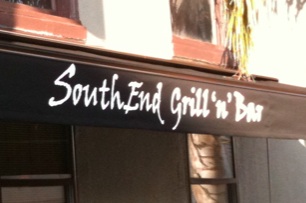

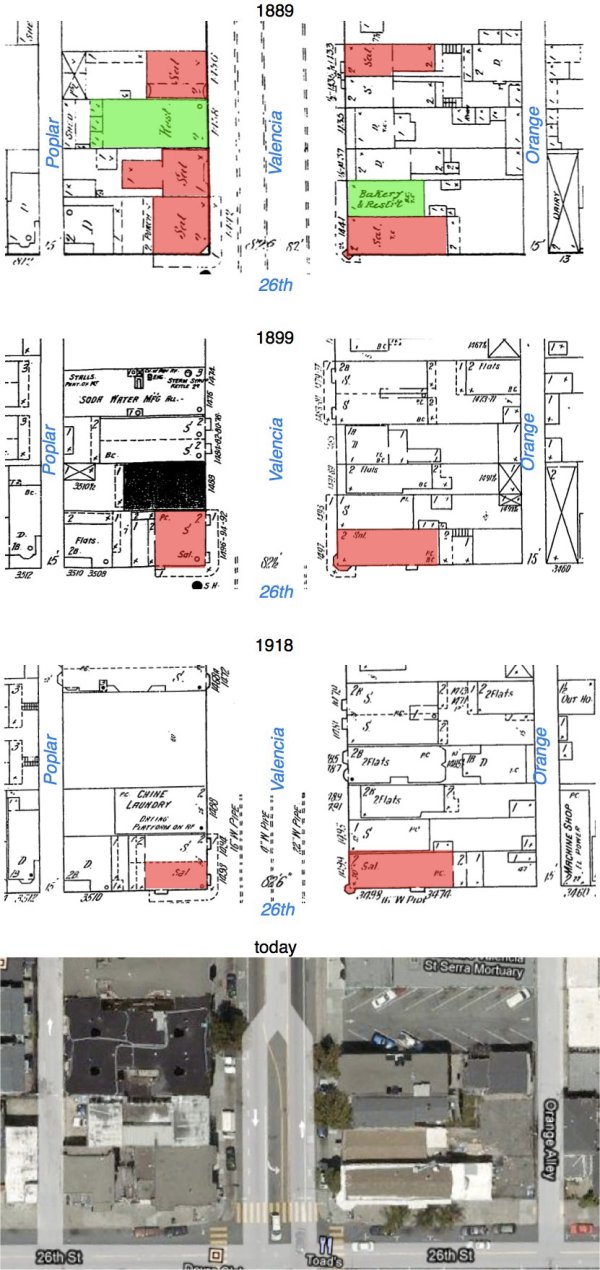


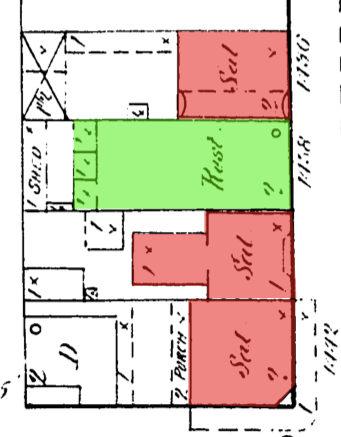











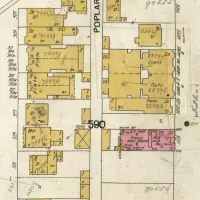



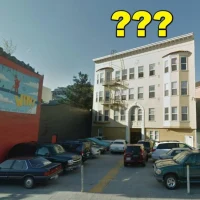

You are my favorite historian of our neighborhood. By far.
You’ve outdone yourself again, good Sir.
A couple of thoughts:
1. Oh, 1889 – back when we could have 5 bars on the same small block. Bourbon Street had nothing on us.
2. I bet the Misses Kittie, Hattie, and Annie Goggin, partygoers three, were enchanting. And dinner at 11! I’d be famished.
I love this. I’m mildly disappointed that it isn’t the same house; I always thought that front room with the four windows looked like a ballroom from the street and I was just starting to picture the party.
what alexis said!!
Alexis is my favorite technology historian so we are good to go.
Here’s the SF Weekly article on how the Dovre got kicked out of the Women’s Center on 18th and Lapidge back in ’97. (The center used to be the home to the Sons of Norway. Good history on the founding of the Lexington as well.)
Another article on the Dovre from SFgate — prior to the Dovre moving lalenguaward, 26th and Valencia was the Schooner Tavern.
“Wandering into the Dovre, you find an amiable mix of Irish citizens, punk-ish Web designers and neighborhood folk who began frequenting the place in 1998, when Brian McElhatton opened the bar at Valencia and 26th streets in what had been the Schooner Tavern. He moved there after the Dovre had finally been bounced from the Women’s Building, which wanted the space and had an oral agreement with Nolan that the bar could stay as long as he was around. The eviction came after a pitched 1 1/2-year battle that included several court cases and defiant action by Dovre partisans like Hinckle and political consultant Jack Davis, who had bars welded over the window and barricaded doors to keep the sheriff at bay.”
TK, I do not know if you will be able to stand the drama of searching for Annie Goggin. A hint as to why she was invited to the party.
“. . . A handsome blonde, just merging from her teens, and of a most charitable disposition.”
Ooooh, a fin de siecle Girl Gone Wild! HOTT.
I live at the current 242 San Jose Ave and was fascinated to read this. The current house was built in 1916 at one time was owned by Mayor Rossi. It is unclear whether he lived there himself or it was bought for a lady friend. He was a florist and there is a bust of him in city hall.
The current owners of Rossi flowers tell us that they have tax records that show his ownership.
Rossi was also a bootlegger and rumor has it that his fortune more than doubled during prohibition. We recently opened a wall in the basement and found more than a case of very old Carta Blanca bottles that probably were holed up there by a resident drunk or construction worker as we think that part of the house was added afterwards.
To the author of this blog, please contact me via email. I’d love to show our house to you and hear more about the hood. You likely know that this part of the city is called Horner’s Addition as it was purchased from farmer Horner to add to the city.
Thanks Danny! I will take you up on that offer.
Digging around the city directories, a guy named John Stelling lived at 242 San Jose from at least 1918-1924. From 1915-1921, Stelling’s occupation is listed as secretary for Rolph Navigation & Coal. (He was a bookkeeper before that, and the general manager for the Pacific Coast Jockey Club afterwards.)
The interesting bit? Rolph Navigation was founded by ‘Sunny Jim’ Rolph, our fine mayor from 1911-1930. Rossi served for 13 years after Sunny Jim became governor…
Anyway, here’s the detail on 242 San Jose from 1911-1924, and the directory listings for John Stelling from 1904 to 1924.
I long chiefly noticed the building that was briefly Toad’s because it was an extreme example of how stucco siding can reveal the underlying rot in foundations of old buildings. From sometime in the ’70s when I first noticed it through sometime in the last decade, the stucco along the curtain wall on the 26th St. side buckled and crumbled until one could see into the crawl space.
Then an owner put in a foundation. Most of the old buildings in San Francisco have undergone this repair or need it. (I did this sort of work in the 70s and 80s so it is a bit of a fixation for me.)
I remember when the Dovre moved. I lived right around the corner and was still a teenager, but was really amazed at the insistence of the Women’s Building to move them out.
toads & south end are owned by the same person. i think he just changed the name / format. still amazing though.
schooner tavern was a neighborhood hangout on this corner in the ’90s. A Sunday night jazz sit in session was the highlight of the week. The anchor was a tenor player who had a couple of records in the late ’50s. There were a number of regular musicians who could tell you about playing with vince guaraldi back in the north beach days.